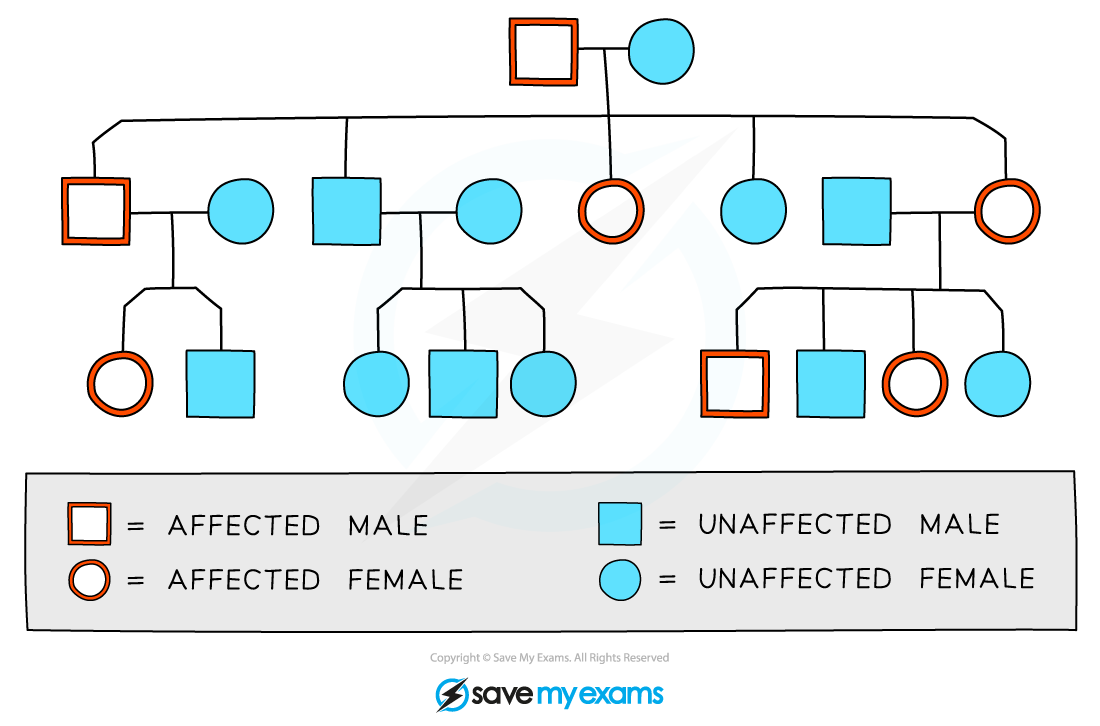Patterns of Inheritance & Sex Linkage (Edexcel International A Level (IAL) Biology) : Revision Note
Key Terms: Genetics
Genes & alleles
A chromosome is a long DNA molecule which contains many genes
A gene is a length of DNA that codes for a single polypeptide
The position of a gene on a chromosome is its locus (plural loci)
Each gene can exist in two or more different forms called alleles
Different alleles of a gene have slightly different nucleotide sequences but they still occupy the same locus on the chromosome
Different alleles arise by the process of mutation
E.g. each allele might produce a different coat colour in mammals
One allele might code for a black coat while the alternative allele might code for a chestnut coat
When writing about genes it is conventional to use a single letter to represent a gene, while different alleles may be indicated by using upper and lower case letters, e.g. A and a
Homozygous & heterozygous
Every individual has two copies of each allele; one on each chromosome in a homologous pair
A homologous pair of chromosomes is a pair of chromosomes that match in size and shape, and that contain the same genes at the same loci
The chromosomes may not contain the same alleles of each gene
One member of a homologous pair of chromosomes comes from one parent, while the other comes from the other parent
When an individual has two identical alleles at a locus they are said to be homozygous, or a homozygote
Homo = the same
When an individual has two different alleles at a locus they are said to be heterozygous, or a heterozygote
Hetero = different

Chromosomes match up to form homologous pairs which have the same genes at the same loci. While the genes are the same, the alleles may be different, meaning that individuals can be either homozygous or heterozygous at a particular locus
Genotype & phenotype
The genotype of an organism refers to the alleles of a gene possessed by that individual
E.g. An organism's genotype could be represented by the letters gg
The genotype of an individual affects their phenotype; a phenotype is the observable characteristics of an organism
E.g. every horse has two copies of a gene for coat colour in all of their cells, one on each homologous pair of chromosomes; the gene could be notated using the letters A and a
A horse that has two A alleles has the genotype AA and is homozygous
If the A allele codes for a black coat, then the phenotype of the horse would be black
A horse that has two a alleles has the genotype aa and is also homozygous
If the a allele codes for a chestnut coat then the phenotype of the horse would be chestnut
Dominant & recessive
Not all alleles affect the phenotype in the same way
Some alleles are dominant; they are always expressed in the phenotype no matter which other allele is present
This means they are expressed in both heterozygous and homozygous individuals, e.g.
A horse with the genotype AA would be said to be homozygous dominant and would have a black coat phenotype
A horse with the genotype Aa would be said to be heterozygous and would still have a black coat phenotype, as the allele for black coat colour is dominant over the lower case allele
It is possible to refer to a heterozygous individual as a carrier of the recessive allele; the allele doesn't show in the phenotype but could still be passed on to offspring
Others are recessive; they are only expressed in the phenotype if no dominant allele is present
This means that it is only expressed when present in a homozygous individual, e.g.
A horse with the genotype aa would be said to be homozygous recessive and would have a chestnut coat phenotype due to the absence of the dominant black allele
Codominance
Sometimes both alleles can be expressed in the phenotype at the same time; this is known as codominance
When an individual is heterozygous they will express both alleles in their phenotype
When writing the genotype for codominance the gene is represented by a capital letter and the alleles are represented by different superscript letters, for example IA
An example of codominance can be seen in coat colour in cattle
The gene for coat colour can be represented by the capital letter C
The alleles for coat colour can be represented by letters R (red) and W (white)
A cow that is homozygous and has a red coat has the genotype CRCR
A cow that is homozygous and has a white coat has the genotype CWCW
A cow that is heterozygous will have a roan coat, containing a mixture of red and white hairs; the genotype will be CRCW
Genetic Pedigree Diagrams
Family pedigree diagrams can be used to trace the pattern of inheritance of a specific trait, e.g. a genetic disorder, through generations of a family
Pedigree diagrams can provide information such as
Whether a trait is caused by a dominant or recessive allele
Whether a trait is more likely to be inherited by males or females
The genotypes of individuals in the family
The probability that an individual in the family will inherit a trait

Pedigree diagrams can be used to show the pattern of inheritance of a genetic trait
Males are indicated by the square shape and females are represented by circles
Affected and unaffected individuals can be indicated using colour, shading, or cross-hatching
Horizontal lines between males and females show that they have produced children
Vertical lines show the relationship between parent and child
Roman numerals may be used to indicate generations
For each generation the eldest child is on the left and each individual is numbered
The family pedigree above shows the following
Both males and females are affected by the trait in question
Every generation has affected individuals
The eldest son in the second generation is affected
There is one family group that has no affected parents or children
The diagram above does not contain enough information to show
Whether the trait is caused by a dominant or recessive allele
The genotypes of the individuals involved
Worked Example
The pedigree diagram below traces the inheritance of albinism through several generations. Albinism affects the production of the pigment melanin leading to lighter hair, skin and eyes.

Using the pedigree chart, deduce and explain the following:
The type of allele that causes albinism
The genotype of individuals 9 and 7
The possible genotypes of 10 and 11
Answer:
Question 1
Albinism is caused by a recessive allele
Person number 9 is an affected individual despite parents 6 and 7 being unaffected; 6 and 7 must both be carriers of the recessive allele and 9 has inherited one recessive allele from each parent
Question 2
The genotype of person 9 must be homozygous recessive (aa) and the genotype of 7 must be heterozygous (Aa)
Person 9 is an affected individual with albinism; as this is determined by the recessive allele they must have two copies of the albinism allele
Person 7 must be heterozygous as he does not have albinism but has passed on the recessive allele to person 9
Question 3
The possible genotypes of 10 and 11 are heterozygous (Aa) or homozygous dominant (AA)
They are both unaffected individuals so must possess at least one dominant allele (A), however, it is possible that they each might have inherited a recessive allele (a) from one parent (both parents must have a copy of the recessive allele in order for person 9 to have albinism)
Examiner Tips and Tricks
When answering questions about pedigree charts for genetic diseases, it is always useful to remember which phenotype is caused by the homozygous recessive genotype. You can write these genotypes onto your chart and it will give you a good starting point for working out the possible genotypes of the rest of the individuals in the chart.
Sex Linkage
Sex-linked genes are located on the sex chromosome
This means the sex of an individual affects which alleles they pass on to their offspring through their gametes
If the gene is on the X chromosome, males (XY), will only have one copy of the gene, whereas females (XX) will have two
The X chromosome has many more genes on it than the Y chromosome, so sex-linkage that involves the Y chromosome is very rare
Sex linkage is notated using a capital letter to represent the chromosome X or Y and a superscript letter to represent the allele
There are three genotypes for females, e.g. for a genetic trait caused by a recessive allele
XAXA = unaffected
XAXa = carrier
XaXa = affected
Males have only two genotypes, e.g.
XAY = unaffected
XaY = affected
It is not possible for males to be carriers of X-linked traits, nor for them to pass such traits on to their sons; males only pass Y chromosomes on to their sons
Worked Example
Red-green colour blindness is a well known sex-linked trait in which individuals find it difficult to distinguish between the colours red and green. It is controlled by is a gene found on the X chromosome; the dominant B allele codes for normal vision and the recessive b allele results in red-green colour blindness.
Use a genetic diagram to show how two parents with normal vision can have offspring with red-green colour blindness.
Answer:
Step 1: Work out the genotypes of the parents
Both parents have normal vision so each must have a copy of the dominant B allele
The father only has one copy of the X chromosome, so his genotype must be XBY
The question tells us that the parents must be able to have a child with colour blindness, so this allele must come from the mother; she must therefore have a copy of the b allele and her genotype must be XBXb
Step 2: Work out which gametes the parents can produce
The genotype XBY will produce gametes containing either XB or Y
The genotype XBXb will produce gametes containing either XB or Xb
Step 3: Use the gametes to complete a Punnett square and then indicate which offspring will be affected
| XB | Y |
XB | XBXB | XBY |
Xb | XB | XbY |
The individual with genotype XbY will be affected by red-green colour blindness; they only have only copy of the X chromosome and it contains the colour blindness allele
Examiner Tips and Tricks
Note that in the worked example above the letter B has been chosen to represent colour blindness rather than the letter C. It can often be a good idea to choose letters for which there is a clear difference between the upper and lower case; this avoids losing marks in exams because examiners can't tell the difference between, e.g. C and c, or S and s

You've read 0 of your 5 free revision notes this week
Unlock more, it's free!
Did this page help you?
